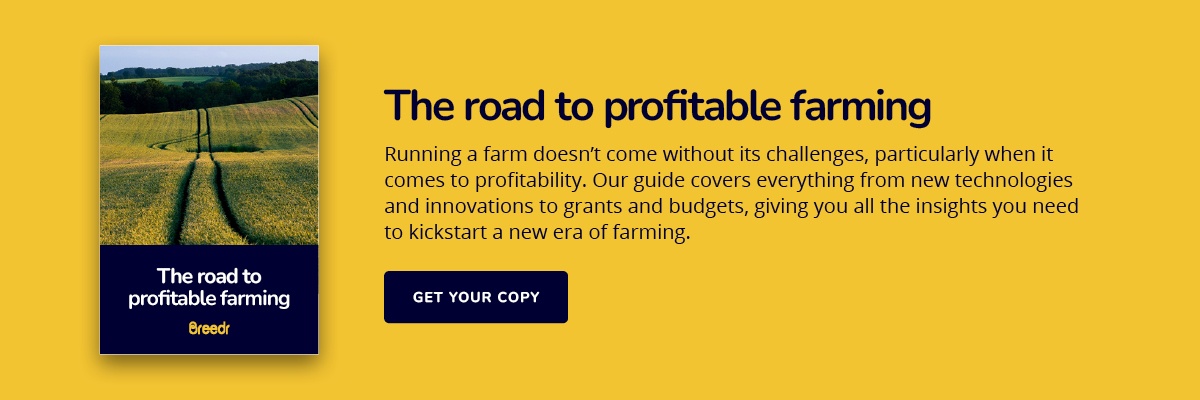Top 9 metrics for you to monitor on your farm
.jpeg)
In the past, it has been difficult to measure what success looks like on a farm. You’re running a business, which means you have goals you want to achieve relating to profitability, efficiency and sustainability.
In recent years, more and more agricultural businesses have been adopting farm metrics to help them achieve these goals. In this article, we’ll run through the top 10 metrics so you can move one step closer to achieving precision farming.
1. Cows and heifers calved within the first six weeks (%)
Farms with a 90% six-week calving rate expect half the herd to calve in 16 to 18 days. When it comes to beef cattle, there are specific calving objectives you should look to achieve. The more calves born in the first three weeks will result in a higher average weaning weight and cow & calf groups will be at the same stage for easier herd management.
2. Cow pregnancy rate (%)
Pregnancy rate is the percentage of cows eligible to be bred in any 21-day period. This farming metric is fundamental to increasing the daily weight of beef sold per cow and generating cows for replacement or sale. Ideally, your business should achieve a 25% pregnancy rate or above. Anything below that highlights room for improvement.
3. Herd replacement rate (%)
When ensuring a successful breeding season, you should retain around 80-82% of your cows to produce a calf again in the next year. A herd replacement rate of 18-21% is the figure you should aim for to achieve your full potential and make a profit.
4. Cow herd efficiency (%)
This farm metric aims to assess the relationship between the weight of your cows and their calf output. You should aim for your cows to wean 40-60% of their liveweight in calves.
To calculate this metric, you need an average liveweight of calves at weaning, an average liveweight of females put to the bull and your average age at weaning (in months). It’s important as it relates to profitability and reflects positive herd fertility.
5. Average gestation period
The most common length of gestation period for cows is 283 days. However, the gestation period can range from 265 to 295 days. There are a range of factors that may affect the gestation period for your beef cattle. One of the most common factors is the sex of the calf. You should aim to achieve a 285 days average gestation.
6. Working capital (%)
This is the amount of money your farm has available for operational expenses. For example, you may need to set some money aside to invest in more livestock during a specific season. This metric is measured on your working capital to gross revenue.
Depending on your type of farm, the working capital to gross revenue percentage you should aim for differs. A working capital to gross revenue ratio of 30% or higher for crop farms and 20% or higher for livestock farms is the current industry standard.
7. Human capital (%)
Human capital encompasses employee knowledge, skills, good health, education and your ability to enable staff to realise their potential. It’s a metric likely to fluctuate depending on current economic conditions. Investing in technology is one of the most effective ways to improve this metric.
For example, more farms are utilising GPS systems to comprehend their crops at a micro level, reduce environmental impacts and conserve resources.
8. Full economic net margin (pence per kilo)
A key driver of profit, full economic net margin allows you to measure your farm’s ability to reinvest, grow and attract a new generation of staff and ownership. It also enables you to compare your performance against farms of different and similar systems. Five to 12 pence per kilo is considered a well-performing full economic net margin — anything below that means there’s room for improvement.
9. Overheads as a percentage of income (%)
Factors such as labour, power and machinery are all interrelated and will impact your business' profit and loss margins. Therefore it’s vital to measure overheads in detail and benchmark where the best farmers are, find detailed areas to focus on and set targets to lower the cost base. By keeping overhead costs as low as possible, you have the best chance of building a continually successful farm in the future.
Understanding metrics and knowing how to measure them isn’t easy. You’re already busy working on your farm and looking for ways to improve productivity to maximise output. That’s why technology has been created to support you in your efforts. Here’s how:
- With the right technology, you can continually monitor and benchmark individual and group growth rates of your animals against national and local farms. This ensures you consistently produce animals that can provide you with a high return on investment.
- You can also seamlessly monitor individual growth rates, current market value, time on-farm and withdrawal status for your animals. This is highly effective in measuring success rates against the metrics listed above.
- Start optimising genetics based on actual breeding values to deliver earlier calving, birthing ease, offspring growth rates and percentage weaned. Also, compare your herd in real-time against national Breedr farms, AHDB guidelines and local farms similar to you. With technology by your side, your farm can always strive to make improvements.
Want to know more about farming technology and how to enhance profitability?
We have just the resource for you. Head over to our profitability page to find out more about future farming trends, opportunities to grow your farm and the role technology has to play in the future of farming.





